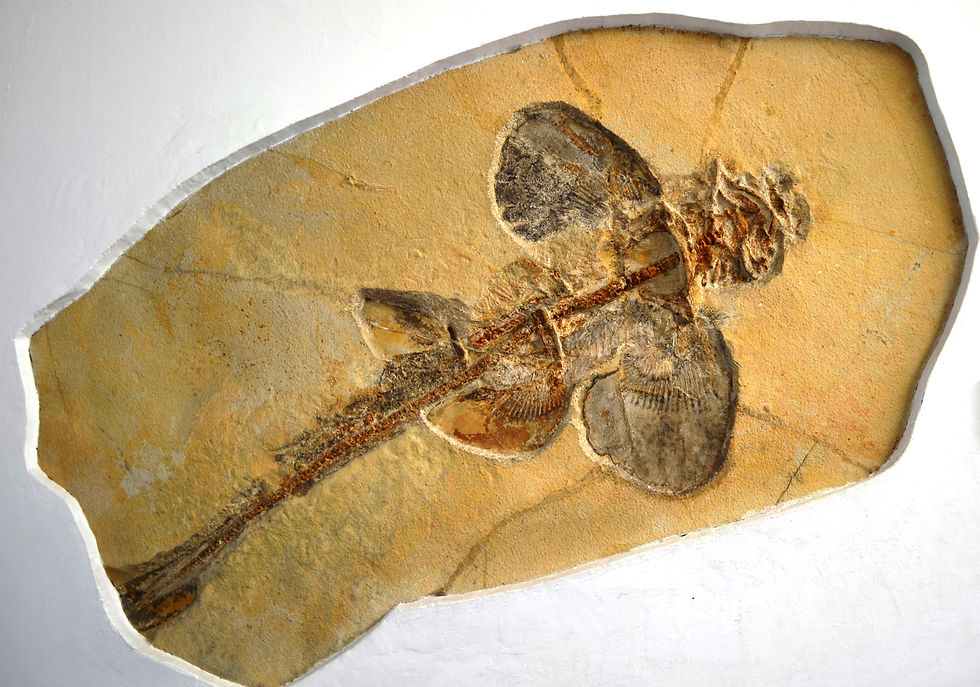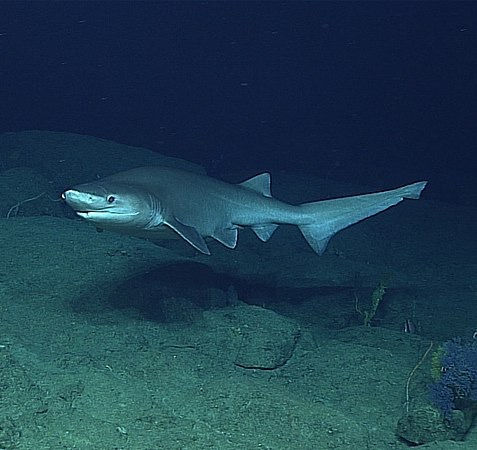I Will Survive!
- Sophie SharkSpeak Maycock

- Sep 1, 2021
- 6 min read
Updated: Dec 4, 2023
Over their 440 million years of evolution, sharks have faced incredible, almost insurmountable challenges! In an ongoing battle for survival, natural selection has weeded out the weakest, pushed up the strongest, and caused sharks and their relatives to evolve in to a myriad of weird and wonderful, different forms. Whilst survival of the fittest is at work in every aspect of shark evolution, there are also cases where extreme events have reeked total havoc and driven species extinct almost at random... Mass extinction events. Sharks have travailed through several! Including the one which killed the dinosaurs! So when did these massive die-offs happen? Which sharks survived? And how has this changed the course of shark evolution?

The Evolution of Sharks
It is difficult to say with any certainty when exactly the first shark appeared. This is because evolution is a gradual process, with subtle adaptations slowly shifting into larger changes over many millions of years. For example, we know of animals that had scales resembling shark skin, living as far back as 455 million years ago (mya). Yet the first jawed ancestors of sharks (known as the "Acathathodians") did not appear until 440 mya. From this point on, we see many different species with 'shark-like forms', but its is difficult to state which is the first true shark. Many believe Cladoselache, which lived around 365 mya, was the first real shark, but others argue they were actually a chimaera and therefore the first real shark was Saivodus, around 340 mya (Ebert et al, 2021).
But what we do know is that sharks and their ancestors have been affected by several major extinction events: The Late Ordovician Mass Extinction (445 - 444 mya), The Late Devonian Mass Extinction (372 - 359 mya), The Permo-Triassic Extinction Event (252 mya), The Triassic-Jurassic Extinction (228 - 201 mya) and The K-T Extinction (66 mya). Modern sharks are the product of those plucky (lucky) individuals that survived all these (Ebert et al, 2021).

The Late Ordovician Mass Extinction
Between 445 - 444 mya, sudden global cooling caused a short ice age, before the climate began to warm again. At this point there was a drop in oxygen levels (known as "ocean anoxia") and a rise in toxic sufide production. Some species could not survive the extreme cold and many others could not survive the depleted oxygen levels or the new toxic conditions. So 85% of all marine species were wiped out! But the ancestors of sharks were able to survive! (Ebert et al, 2021)
After this extinction event, in fossils dated to between 440 - 435 mya, we find evidence of the "Acathodians" - the first common ancestor of all cartilaginous fishes (aka Chondrichthyans), which includes the modern sharks, skates, rays and chimaeras. These ancestors further evolved into many 'shark-like forms', including Doloidus problematicus and Antarcilamna (Ebert et al, 2021). But the worst was not yet over!

The Late Devonian Mass Extinction
* Also known as the "Kellwasser event" or the "Frasnian-Famennian extinction"
70 or so million years later, Earth threw another challenge at the ancestors of sharks... During an extinction event that had several different phases and lasted somewhere between 500,000 and 25 million years, there was yet more ocean anoxia, huge sea level rises, catastrophic global cooling, major volcanic events and possibly even a meteor strike to boot! As a result, 70% of all marine species were once again wiped out! (Ebert et al, 2021)

However, it was all this death which made way for the sharks! Before this extinction event, the oceans were dominated by primitive jawed fish, known as placoderms, ammonites and armoured jawless fish, known as ostracoderms. With their extinction, the sharks and their relatives had much more space and less competition, so they began to flourish! In fact, this period is known as "The Golden Age of Sharks", with remarkable diversity of forms! Shark-like relatives known as chimearas became especially diverse, with some truly bizarre and spectacular features evolving! Some examples include the famous Falcatus (320 mya) and Helicoprion (290 mya) (Ebert et al, 2021). But it was not going to be smooth sailing for these sharks...

The Permo-Triassic Extinction Event
* aka the End-Permian Extinction or The Great Dying
Around 252 mya, massive volcanic eruptions caused global warming and significant changes to ocean chemistry, which resulted in THE Largest extinction event to date. As many as 96% of all marine species, including corals and trilobites, were completely wiped out, and 70% of all land animals were also killed off. This marked the end of a period of remarkable diversity amongst sharks and their relatives (Ebert et al, 2021).

Yet, a few lineages survived into the Triassic period! In fact, the first "Neoselachians" aka the modern sharks, made it through! And during the subsequent period, sharks resurged. "Hybodont sharks" - close relatives of modern sharks - became especially dominant and diverse (Ebert et al, 2021)... Yet, these sharks were doomed...

The Triassic-Jurassic Extinction
Around 20 million years later, a gradual change in climatic conditions, changing sea-levels and ocean acidification over approximately a 30 million year period, caused the extinction of up to 75% of all marine and terrestrial animals yet again. This included many of the sharks, and also reptiles and amphibians (Ebert et al, 2021).

And yet, the sharks persisted through to enjoy quite a long period of relative stability afterwards. Following the Triassic-Jurassic extinction, sharks became very common in the oceans, and sharks and rays began to diversify into some of the forms that are familiar to us today! (Ebert et al, 2021)
For example, around 195 mya, the first Hexanchid sharks appeared. This lineage is what gave rise to the Hexanchiform sharks, including the six-gills and seven-gills that are still around today! At around 185 mya, the earliest types of rays, known as Protospinax also came into being! Then came catsharks (168 mya)... mackerel sharks and stingrays (135 mya)... lantern sharks and the magnificent Aquiolamna ray (90 mya) (Ebert et al, 2021; Vullo et al, 2021) (to learn more about these fantastic creatures check out Sharks are Older than Trees!) Yet, unbeknownst to them, the sharks had one final, great hurdle to cross...
The K-T Extinction Event
* aka the Cretaceous–Tertiary Extinction or The one-that-killed-the-dinosuars
The final mass extinction event is familiar to us all... a mighty asteroid struck the Earth 66 million years ago, and the enormous amounts of dust and ash which were flung into the atmosphere caused an immediate global climate shift. This killed 75% of all species, including many plants, all ammonites, mososaurs and, of course, the dinosaurs. In the oceans the vast majority of very large predatory sharks and rays were also driven extinct (Ebert et al, 2021).
And yet, after a few very small, deep sea sharks managed to survive this disaster, some of the most iconic sharks evolved ... including Otodus (60 mya) and the mighty Megalodon (20 mya). Several million years later, we enjoy over 500 different species of sharks and more than 700 rays! (Ebert et al, 2021).

Survival of the Fittest
Sharks have been through an awful lot to get to where they are today. Their ancestors have been through ice ages, continental shifting, volcanic eruptions, major climate changes and meteors... they are true survivors!

And yet, there are concerns that sharks (along with many other animals) may not be able to weather the 6th great mass extinction event... the "Anthropocene". The man-made extinction event. Today, sharks are being killed by humans beings at an incredible rate and hundreds of species have been driven to the brink of extinction. Anthropogenic climate change, ocean acidification and deoxygenation, urbanisation, habitat degradation and loss, overfishing, finning, pollution... all these things are an unprecedented threat to sharks, causing population declines at rates we have never recorded before. It is critical that we turn it around - change our ways, do better and combat climate change however we can. It is unacceptable that we are doing more damage to this Earth than an asteroid so huge it wiped out the dinosaurs!
To learn more see our other palaeontology articles.
References
Ebert DA, Dando M& Fowler S (2021). Sharks of the World: A Complete Guide, Second Edition. Princeton University Press: UK. IBAN: 978-0-691-20599-1.
Vullo R, Frey E, Ifrim C, González MAG, Stinnesbeck ES & Stinnesbeck W (2021).
Manta-like planktivorous sharks in Late Cretaceous oceans. Science, 371:6535, 1253-1256. Access online.
By Sophie A. Maycock for SharkSpeak











I’ve made $84,000 so far this year working online and I’m a full time student. I’m using an online business opportunity I heard about and I’ve made such great money. It’s really user friendly and I’m just so happy that I found out about it. The potential with this is endless.
Here’s what I do… https://Www.Go.richjob2.com
JOIN US Everybody can earn 250/h Dollar + daily 1K… You can earn from 6000-12000 Dollar a month or even more if you work as a part time job…It’s easy, just follow instructions on this page, read it carefully from start to finish… It’s a flexible job but a good earning opportunity. tab for more detail thank you……..
Just join This Website ——-⫸ https://Www.EarnApp1.Com
I get paid more than $120 to $130 per hour for working online. I heard about this job 3 months ago and after joining this i have earned easily $15k from this without having online working skills.
This is what I do....... Www.Works6.Com